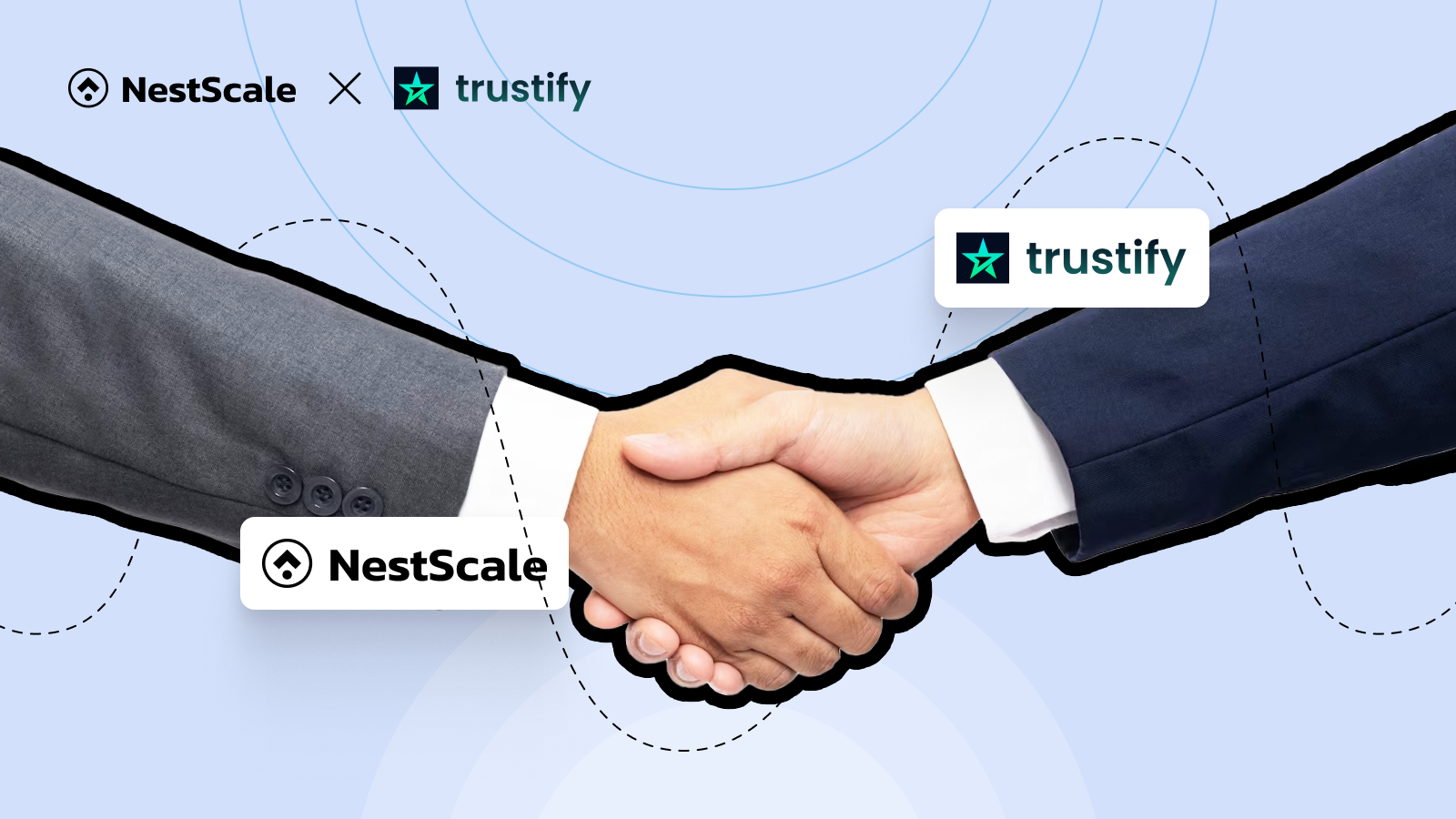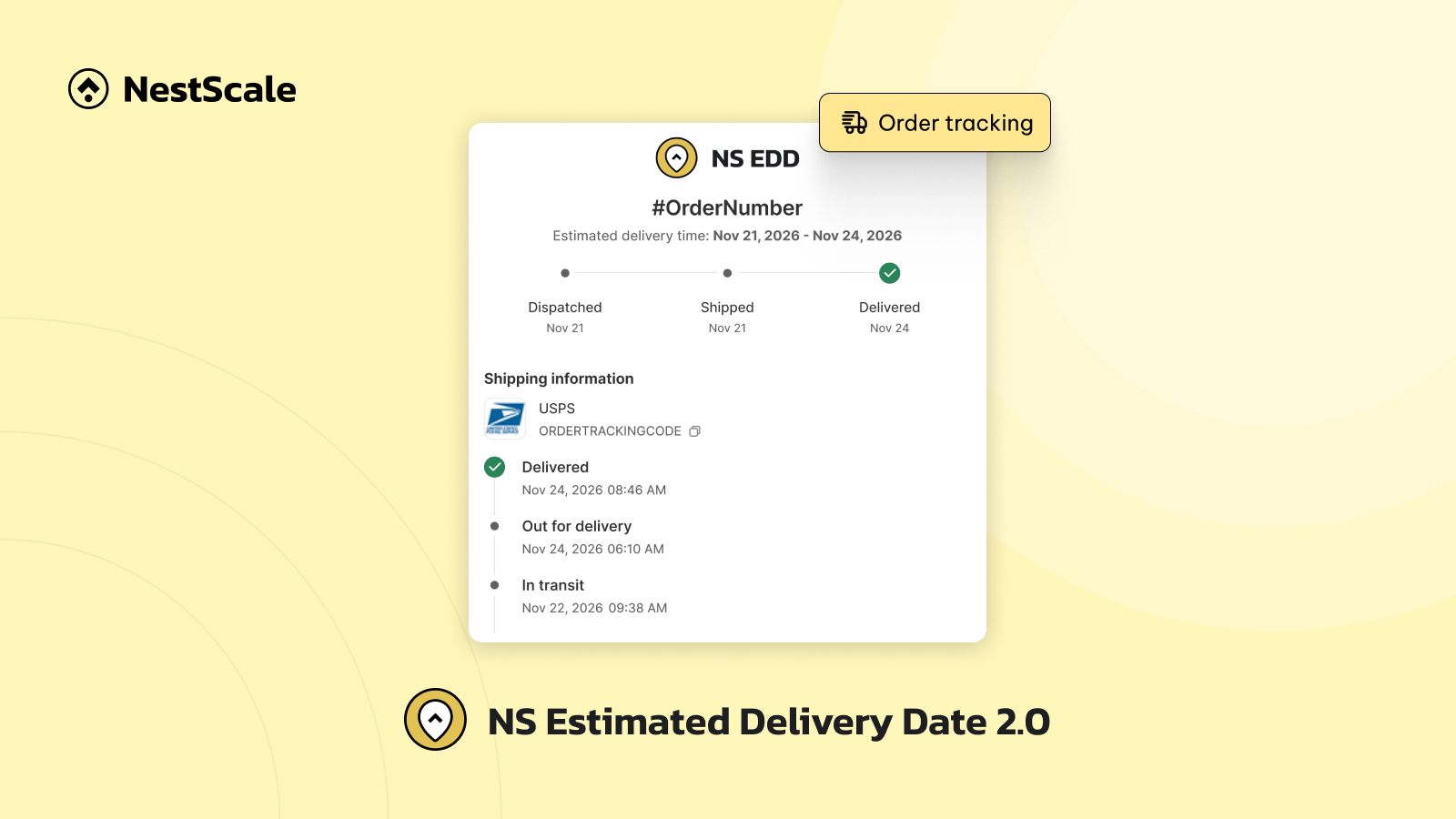Hey there! Have you ever wondered how to make sense of the ever-evolving landscape of customer touchpoints and marketing channels? Well, the answer lies in using marketing attribution models! And one of the rising stars these days is the Time Decay Attribution Model – a secret weapon for understanding your customer and maximizing your marketing efforts.
In this blog, we’ll provide you with everything you need about this attribution model and how to harness its power to stay ahead of the competition. Plus, we’ll accompany you with a simple example of a successful usage of this model. So, get comfy, and let’s dive into the fascinating world of Time Decay Attribution!
What is time decay attribution model?
Time decay is a multi-touch attribution model that distributes credit to all events happening in a customer’s decision journey. Unlike the linear attribution model which assigns equal credit to all events, this model distributes the credit based on when these interactions occur. In other words, an event will receive more recognition as it gets closer to the time of the conversion.
How does time decay attribution model work?
For example, let’s say you receive a new purchase from a customer – which is exactly what you want. Now, when you check your data, here’s what you find about that customer’s journey before making that purchase:
- About a week before buying, they clicked on a TikTok ad for your store and checked out your website. While on your website, they signed up for your newsletter, and you got their info.
- Then, four days before the purchase, this person searched for your store’s name on Google. He came to your website spent some time there.
- On the day they finally decided to make the purchase, they saw your email, clicked on it, and got directed to your website again. This time, they decided to go ahead and buy your products.
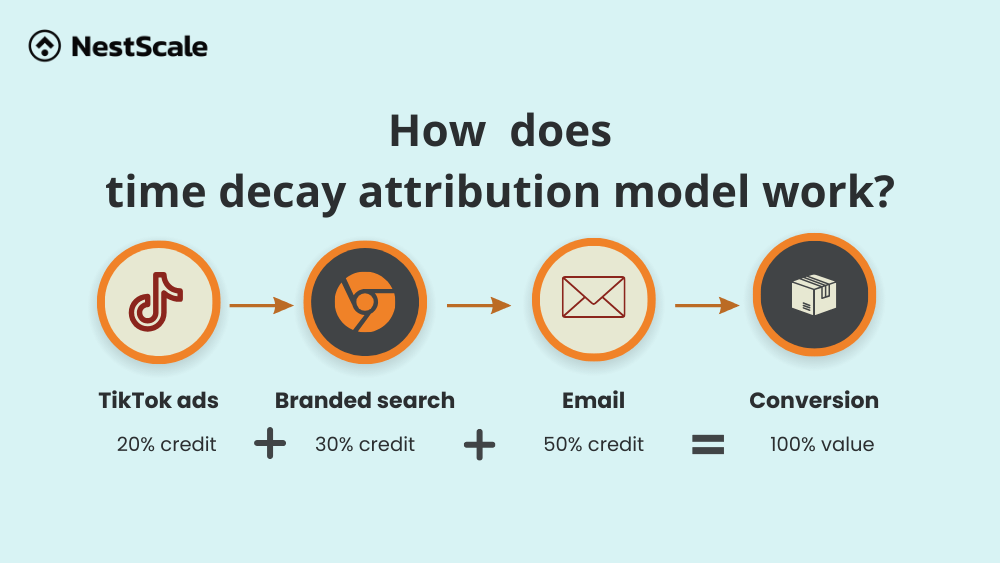
If you’re using a time decay attribution model to track your campaign, here’s how the order value credit is divided. TikTok ads get the least credit, followed by Google-branded search, and email newsletters get the lion’s share of the conversion value. The proportion each received will depend on the attribution platform that you use, or how you calculate the decay rate.
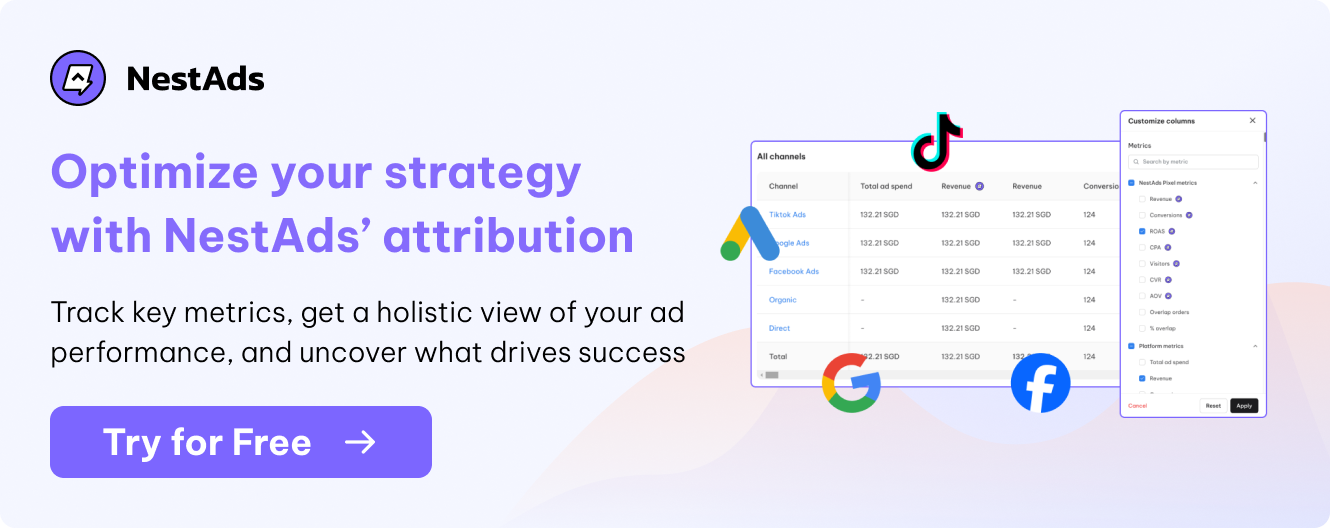
Pros of using the time decay attribution model
There’s got to be a good reason why time decay attribution is getting all this buzz. Well, it’s because it’s a pretty darn useful method for businesses to measure their marketing efforts. So, let’s take you through some of the most notable benefits of this model
Value all of the touchpoints
The time decay attribution model is pretty similar to the last-click attribution model. Just like this popular attribution model, the time decay model also gives more credit to the most recent touchpoint that happens after the conversion.
However, if the last-click attribution doesn’t take into account other marketing channels on the customer journey, the time decay attribution will let you see all the contributions of other channels besides the most recent one. This is really beneficial if you want to have a clear look at the whole customer journey and see how all channels cooperate with each other and give you the result.
For example, you run an online shoe store. Someone wanted a new pair of shoes, and they came across your ads on Instagram. They saw a shoe model from your brand and really liked it. However, they were hesitant to buy it because they didn’t have enough budget. As time passed by, their budget grew, and they also came across some other ads of yours a few times. Finally, they decided to search for your brand to find your website and make the purchase.
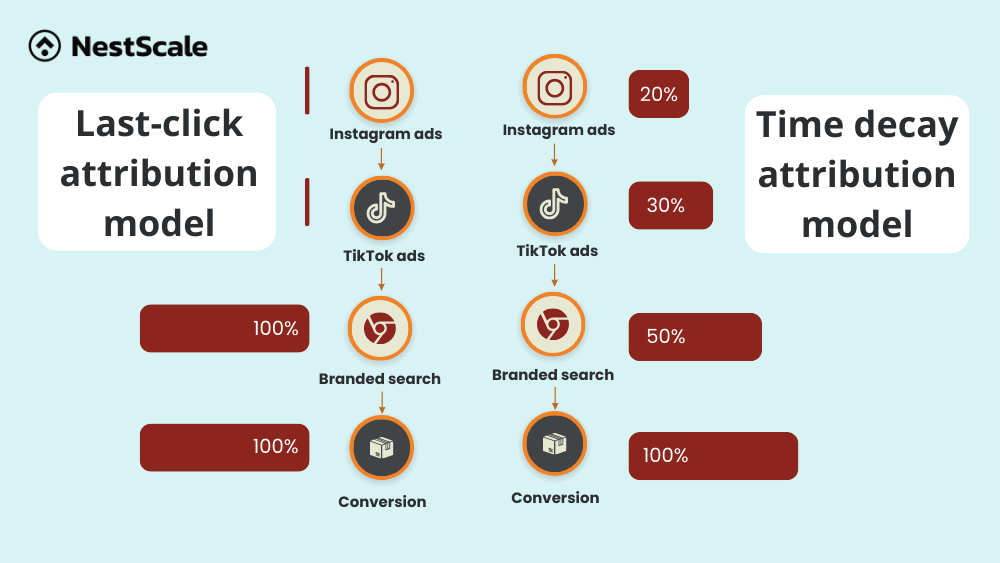
From this example, we can see that the last touchpoint before the customer made a purchase was a branded search. However, they had to go through quite a long journey, starting from their first impression with your Instagram ads, then other social ads, before finally making a purchase. All of these touchpoints still had an impact on the customer’s decision journey. And the time decay attribution model can help you trace that journey to make better decisions.
Determine the direct channels contributing to conversion
This marketing attribution model can help you figure out which marketing channel is bringing in the most profit. This is especially useful when the last interaction isn’t something they did intentionally, like direct click or branded search.
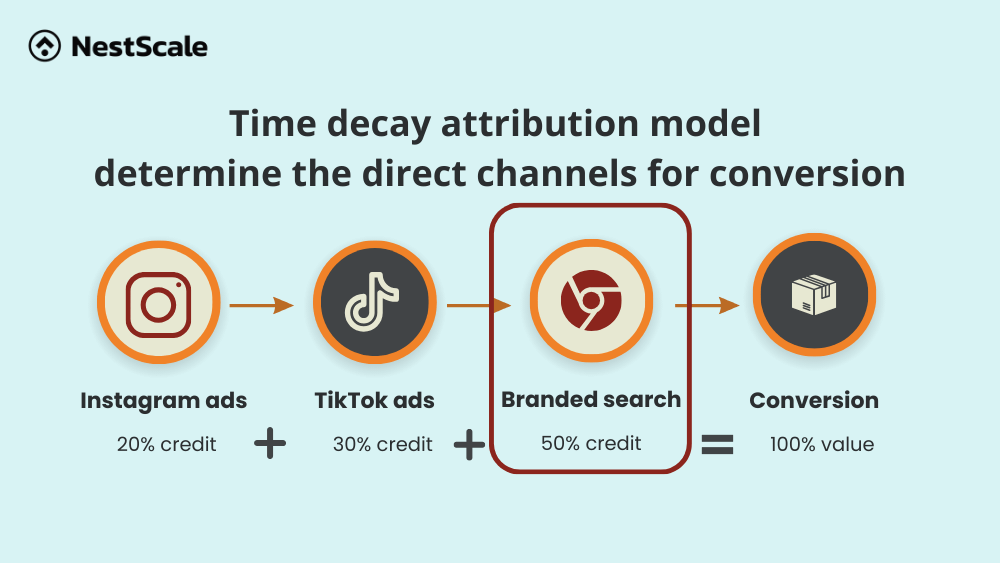
We all know that during a customer’s journey to buy something, they come across many different marketing channels. However, most of these interactions are pretty short and don’t leave a deep impression. That’s why the channels that show up right before the purchase should be the ones that make the strongest impact on your customers’ minds. These are the most effective marketing channels you should focus on to boost sales and increase your profits.
Suitable for long sales cycle
If you have a short sales cycle and only a few marketing channels, using a single-touch model will work just fine. But, when it comes to businesses with longer sales cycles, it’s a different story. Long sales cycles typically involve more touchpoints and a longer time between their first impression and purchase. That’s why, it’s better to use an attribution model that can help you track all the interactions and see the big picture.
Imagine you run an e-commerce store selling software products. These products usually require customers to take their time and make careful decisions. Customers often do research and read reviews on social media before making a choice. In this scenario, you’d want to understand the entire journey that leads a customer to their final decision, not just the last step that results in a conversion.
This is where the time decay attribution model comes in handy. It still shows you the conversion point that’s effective, but it also allows you to see the whole customer journey.
Cons of using the time decay attribution model
Alongside those flashy benefits you can enjoy, the time decay attribution model also has its share of drawbacks. It’s crucial to take these into account because they’ll play a significant role in deciding whether this model fits your business or not. Here’s a list of the disadvantages of this model:
Underestimate the first touchpoint
Similar to the last-click model, the time decay attribution model also tends to overlook the contribution of the first touchpoint. This can be a drawback because the first touchpoint doesn’t always have the least impact. In fact, sometimes, it’s the most crucial and challenging part that keeps customers engaged with your business.
Let’s revisit our example of the e-commerce shoe store. Sure, the last contribution, which is the branded search, gets the most credit. But think about it—without that first touchpoint, the Instagram ads, the customer wouldn’t even know your brand or even consider your products when they had enough budget. This clearly shows how important that initial touchpoint can be.
Difficult to determine the optimal decay rate
Time decay attribution is great for analyzing how time affects a campaign’s effectiveness. However, it can be tricky to figure out the perfect decay rate, which determines how much value touchpoints lose over time. If you set the rate too high, early touchpoints in the customer journey might not get the credit they deserve. On the flip side, if it’s set too low, touchpoints near the conversion might not get the credit they should.
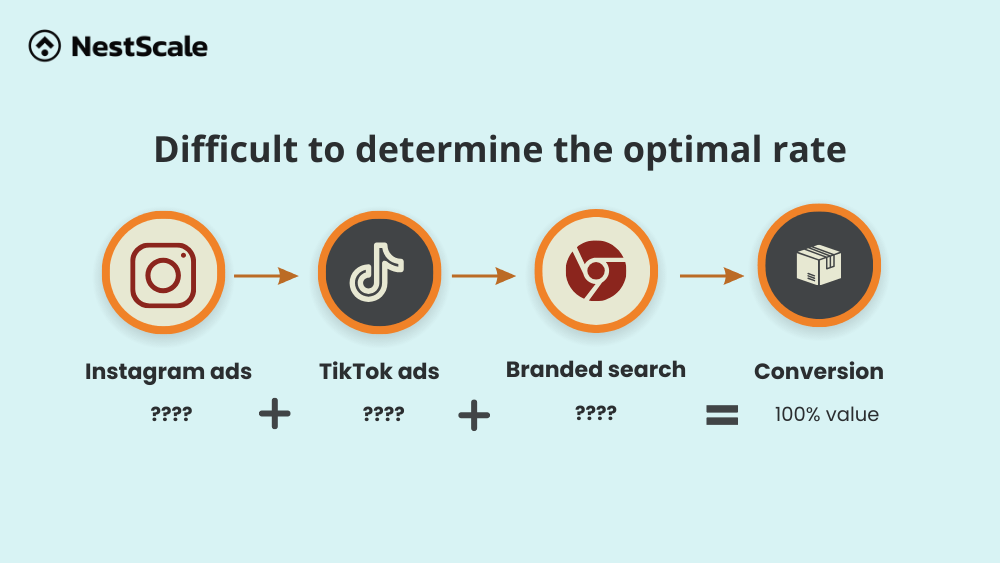
Should your business use this marketing attribution model?
So, now you know about the time-decay marketing attribution model. It’s a fantastic multi-channel analysis tool with plenty of advantages. However, like other multi-touch attribution models out there, time decay attribution isn’t a one-size-fits-all solution.
Therefore, when considering whether you can use this marketing attribution model, you should take some factors into account.
- Examine customer behavior: Understand how your customers engage with your brand. Do they conduct extensive research and consider multiple options before buying, or do they make decisions quickly? If your customers follow a complex and lengthy decision-making process, time decay attribution may offer valuable insights.
- Set objectives: Clarify your business objectives. Are you looking to understand the entire customer journey, or are you primarily interested in the final touchpoints that drive immediate conversions? Your objectives will influence the choice of attribution model.
- Analyze your sales cycle: Consider the typical length of your sales cycle. If your customers tend to make quick purchase decisions shortly after interacting with your marketing touchpoints, a different attribution model like last-click may be more suitable. However, if your sales cycle is longer and involves multiple touchpoints, time decay attribution may be worth exploring.
- The supportive tools: Time decay attribution can be quite complex to calculate without the right tools. So, if you’re considering using this model, make sure you have all the necessary technology in place.
Leverage your marketing effort with the marketing attribution model now!
No matter which marketing attribution model you’re going to use, it’s recommended that you use a tool that is simple, yet still complies with all the functions you need for analyzing purposes. It should be able to give you an overview picture, yet still can have a close look whenever you need.
Check out NestAds – our marketing attribution for e-commerce. It provides you with an exclusive attribution called NestAds attribution model. With NestAds, you can accurately track your marketing effort and deeply understand your customer journey. Ready to reduce your wasted ad spend and improve your ad performance?
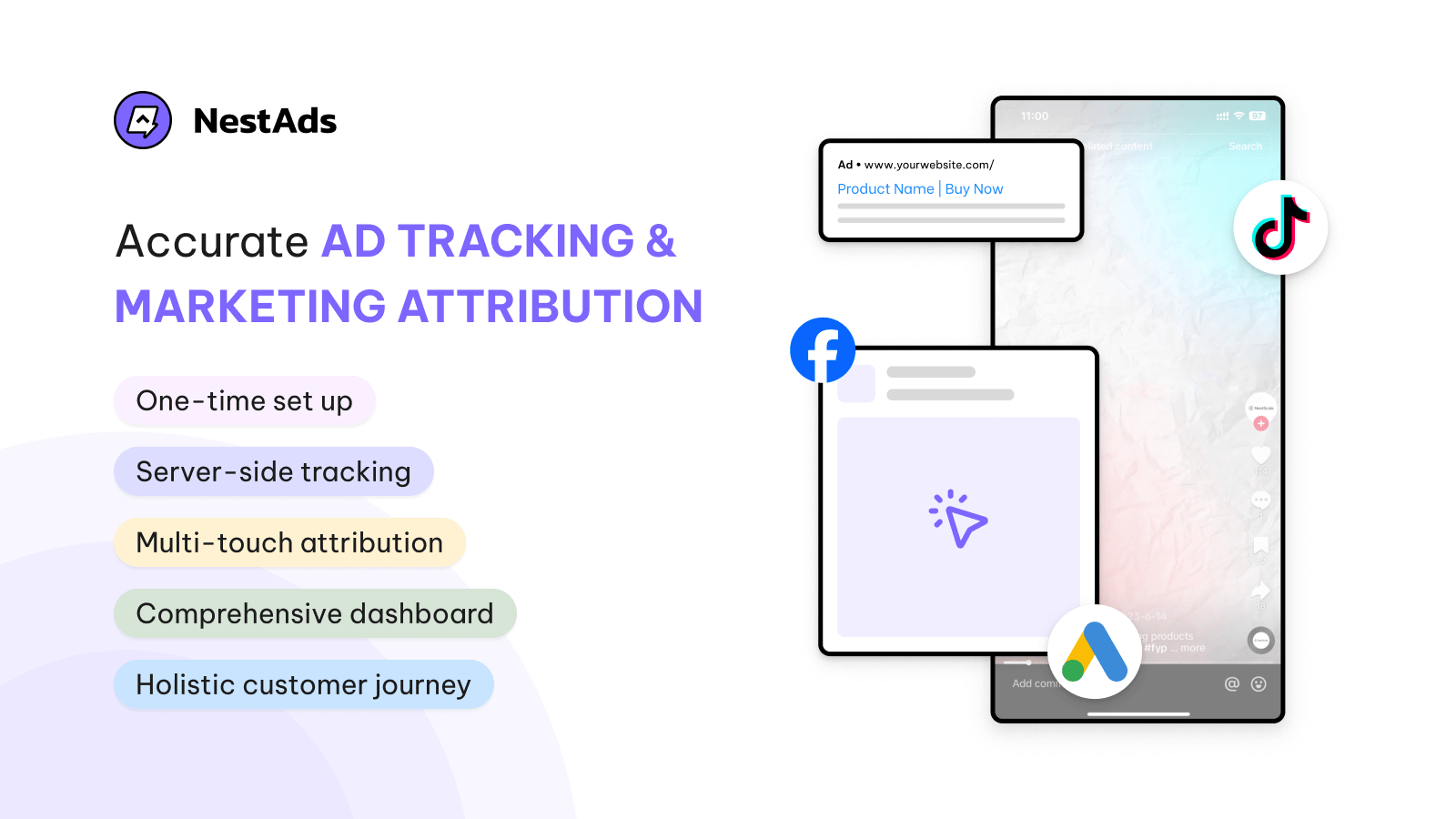
FAQs – What you may want to know more
What is an example of a time decay attribution model?
Imagine a customer interacts with your brand through three touchpoints over a week: An email, a social media ad, and a website visit. If the website visit happens just before the purchase, it might receive 60% of the credit, the social media ad 30%, and the email 10%.
What are the limitations of time decay attribution model?
The drawbacks of the time decay attribution model are most evident when it favors recent interactions, which can lead to undervaluing earlier touchpoints that are key to building awareness and interest. For businesses with longer sales cycles, this can be an issue, as those early touchpoints might not get the credit they deserve.
It also tends to miss how multiple channels work together to drive conversions, which can result in some misattribution. By focusing mostly on how close a touchpoint is to the final conversion, it oversimplifies the customer journey and may not always reflect the true value of each interaction.
How to avoid time decay attribution model bias?
To avoid bias in the time decay attribution model, combine it with other models like linear or position-based to get a fuller picture of your customer journey.
This helps ensure you’re not overvaluing the most recent touchpoints and are giving credit where it’s due across all interactions. Keep evaluating and tweaking your approach to stay aligned with real customer behavior.
















































